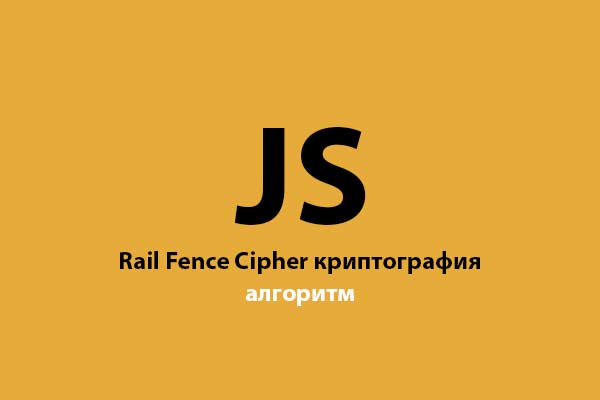
Javascript: криптографический алгоритм Rail Fence Cipher для шифрования строк
Криптографический алгоритм Rail Fence Cipher он же зигзагообразный шифр, служит для того что-бы кодировать строки путем перестановки букв.
Работа скрипта начинается с левого верхнего угла и далее следует по диагонали.
Помимо строки для шифрования нам потребуется указать количество так называемых рельс, достигнув которого скрипт будет менять свое зигзагообразное направление.
Визуализация алгоритма шифрования
- Строка для шифрования: WE ARE DISCOVERED. FLEE AT ONCE
- Количество рельс: 3
W . . . E . . . C . . . R . . . L . . . T . . . E
. E . R . D . S . O . E . E . F . E . A . O . C .
. . A . . . I . . . V . . . D . . . E . . . N . .
-------------------------------------------------
WECRLTEERDSOEEFEAOCAIVDEN
Ниже в статье вы найдете две основные функции для шифровки и расшифровки: encodeRailFenceCipher и decodeRailFenceCipher, а также сопутствующие функции и константы.
Javascript алгоритм Rail Fence Cipher
/**
* @typedef {string[]} Rail
* @typedef {Rail[]} Fence
* @typedef {number} Direction
*/
/**
* @constant DIRECTIONS
* @type {object}
* @property {Direction} UP
* @property {Direction} DOWN
*/
const DIRECTIONS = { UP: -1, DOWN: 1 };
/**
* Builds a fence with a specific number of rows.
*
* @param {number} rowsNum
* @returns {Fence}
*/
const buildFence = (rowsNum) => Array(rowsNum)
.fill(null)
.map(() => []);
/**
* Get next direction to move (based on the current one) while traversing the fence.
*
* @param {object} params
* @param {number} params.railCount - Number of rows in the fence
* @param {number} params.currentRail - Current row that we're visiting
* @param {Direction} params.direction - Current direction
* @returns {Direction} - The next direction to take
*/
const getNextDirection = ({ railCount, currentRail, direction }) => {
switch (currentRail) {
case 0:
// Go down if we're on top of the fence.
return DIRECTIONS.DOWN;
case railCount - 1:
// Go up if we're at the bottom of the fence.
return DIRECTIONS.UP;
default:
// Continue with the same direction if we're in the middle of the fence.
return direction;
}
};
/**
* @param {number} targetRailIndex
* @param {string} letter
* @returns {Function}
*/
const addCharToRail = (targetRailIndex, letter) => {
/**
* Given a rail, adds a char to it if it matches a targetIndex.
*
* @param {Rail} rail
* @param {number} currentRail
* @returns {Rail}
*/
function onEachRail(rail, currentRail) {
return currentRail === targetRailIndex
? [...rail, letter]
: rail;
}
return onEachRail;
};
/**
* Hangs the characters on the fence.
*
* @param {object} params
* @param {Fence} params.fence
* @param {number} params.currentRail
* @param {Direction} params.direction
* @param {string[]} params.chars
* @returns {Fence}
*/
const fillEncodeFence = ({
fence,
currentRail,
direction,
chars,
}) => {
if (chars.length === 0) {
// All chars have been placed on a fence.
return fence;
}
const railCount = fence.length;
// Getting the next character to place on a fence.
const [letter, ...nextChars] = chars;
const nextDirection = getNextDirection({
railCount,
currentRail,
direction,
});
return fillEncodeFence({
fence: fence.map(addCharToRail(currentRail, letter)),
currentRail: currentRail + nextDirection,
direction: nextDirection,
chars: nextChars,
});
};
/**
* @param {object} params
* @param {number} params.strLen
* @param {string[]} params.chars
* @param {Fence} params.fence
* @param {number} params.targetRail
* @param {Direction} params.direction
* @param {number[]} params.coords
* @returns {Fence}
*/
const fillDecodeFence = (params) => {
const {
strLen, chars, fence, targetRail, direction, coords,
} = params;
const railCount = fence.length;
if (chars.length === 0) {
return fence;
}
const [currentRail, currentColumn] = coords;
const shouldGoNextRail = currentColumn === strLen - 1;
const nextDirection = shouldGoNextRail
? DIRECTIONS.DOWN
: getNextDirection(
{ railCount, currentRail, direction },
);
const nextRail = shouldGoNextRail ? targetRail + 1 : targetRail;
const nextCoords = [
shouldGoNextRail ? 0 : currentRail + nextDirection,
shouldGoNextRail ? 0 : currentColumn + 1,
];
const shouldAddChar = currentRail === targetRail;
const [currentChar, ...remainderChars] = chars;
const nextString = shouldAddChar ? remainderChars : chars;
const nextFence = shouldAddChar ? fence.map(addCharToRail(currentRail, currentChar)) : fence;
return fillDecodeFence({
strLen,
chars: nextString,
fence: nextFence,
targetRail: nextRail,
direction: nextDirection,
coords: nextCoords,
});
};
/**
* @param {object} params
* @param {number} params.strLen
* @param {Fence} params.fence
* @param {number} params.currentRail
* @param {Direction} params.direction
* @param {number[]} params.code
* @returns {string}
*/
const decodeFence = (params) => {
const {
strLen,
fence,
currentRail,
direction,
code,
} = params;
if (code.length === strLen) {
return code.join('');
}
const railCount = fence.length;
const [currentChar, ...nextRail] = fence[currentRail];
const nextDirection = getNextDirection(
{ railCount, currentRail, direction },
);
return decodeFence({
railCount,
strLen,
currentRail: currentRail + nextDirection,
direction: nextDirection,
code: [...code, currentChar],
fence: fence.map((rail, idx) => (idx === currentRail ? nextRail : rail)),
});
};
/**
* Encodes the message using Rail Fence Cipher.
*
* @param {string} string - The string to be encoded
* @param {number} railCount - The number of rails in a fence
* @returns {string} - Encoded string
*/
export const encodeRailFenceCipher = (string, railCount) => {
const fence = buildFence(railCount);
const filledFence = fillEncodeFence({
fence,
currentRail: 0,
direction: DIRECTIONS.DOWN,
chars: string.split(''),
});
return filledFence.flat().join('');
};
/**
* Decodes the message using Rail Fence Cipher.
*
* @param {string} string - Encoded string
* @param {number} railCount - The number of rows in a fence
* @returns {string} - Decoded string.
*/
export const decodeRailFenceCipher = (string, railCount) => {
const strLen = string.length;
const emptyFence = buildFence(railCount);
const filledFence = fillDecodeFence({
strLen,
chars: string.split(''),
fence: emptyFence,
targetRail: 0,
direction: DIRECTIONS.DOWN,
coords: [0, 0],
});
return decodeFence({
strLen,
fence: filledFence,
currentRail: 0,
direction: DIRECTIONS.DOWN,
code: [],
});
};
